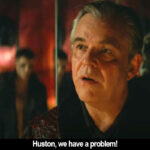**/****
starring Willa Fitzgerald, Kyle Gallner, Madisen Beaty, Barbara Hershey
written and directed by JT Mollner
by Walter Chaw Defenders will say that JT Mollner’s Strange Darling exists, in an ancillary way, in the Martyrs universe, but it isn’t playing the same game. It lacks that movie’s meanness, for one; for another, it lacks the discipline required of ecclesiastical curiosity, the doom and fear and loathing that comes with any honest spiritual examination of the biological roots of fear. I want to call it “Martyrs for Dummies,” but that’s not exactly right, either. The only things Strange Darling ultimately shares with it–and with Christopher Nolan’s Memento–are a destabilizing narrative and an unreliable protagonist. It lacks the rigour of Martyrs and Memento, too, a clear grasp of what it’s after and how. When all’s said and done, Martyrs, which has nothing to do with Clive Barker, remains the truest adaptation of Barker’s marriage of atrocity and communion that I’ve ever seen. Strange Darling is mostly a life-support machine for a twist given away by its title. It’s like handing someone a ukulele in wrapping paper. Surprise! A gimmick tied to a high concept. A Shyamalan flick shot like a series of 1970s grindhouse trailers, featuring a lot of good work in the service of a disappointing puzzle box. Worse is that one of its red herrings involves consent and BDSM, which, you know, are serious and personal issues dangerously marginalized in horror movies that want to treat kink like a moral issue in need of correcting. Imagine the version of Strange Darling that follows through on the idea that a perfectly normal person might like to get stepped on between the sheets. Even better, imagine the version of the film interested in asking: If there is a line, how hard would one need to push to turn a “nice” man into a violent rapist?
Alas, Strange Darling is a mighty tease. Who’s the wolf? The one who looks like a wolf, or the wolf in sheep’s clothing? Only one would be strange, darling. Calling itself a “Thriller in 6 Chapters,” the picture begins in the middle, jumps back to the beginning, jumps forward to the ending, then…how many is that so far? Chronologically, it starts with bad girl The Lady (Willa Fitzgerald) riding in the front seat of a truck with The Demon (Kyle Gallner), negotiating a naughty roll in the hay with a quirky safe word, as one does. She wants it to get really scary, see, super rapey, and though The Demon is reluctant, we suspect that since he’s credited as “The Demon,” maybe he’s playing the part of mensch until he can reveal his true face. Because Strange Darling is presented out of sequence, we’ve already seen The Demon hunting The Lady through the woods, so now our antennae are really up. It’s not, “When will he turn into a BigBad?” but rather, “How will Mollner trick us into thinking he’s turned into a BigBad while revealing that The Lady is actually the BigBad?” A better question Mollner might have asked himself is, “How can one make a woman into a ‘BigBad’ in a rape fantasy without some kind of Ms. 45 explication–and also without equating a woman’s violent sexual fantasies with dangerous mental and social perversion?” There’s a risk here of making broad statements about personal predilections–generalizations about women that perpetuate stereotypes and misconceptions around the ties between promiscuity and patriarchal morality. I don’t mind engaging in the conversation; I do worry that Strange Darling is just saying it’s “strange” and leaving it at that.
Shame Strange Darling wants so badly to fool you that it squanders the amazing elements it’s assembled. Harry Houdini, Ricky Jay, and the Amazing Kreskin, together for one night only for an evening of “gotch’r nose!” Fitzgerald is agile as both lion and lamb: the maiden and the dragon as the picture arbitrarily dictates. She’s so good that I forgave her character for committing an act so unbelievably stupid that, by all rights, it should have scuttled the entire production. Also in fine form is Gallner, now meek and apologetic, now roused to priapic rage. I love how he repeats a Warren Beatty-esque pickup line prior to pumping shotgun shells into a series of hope chests and steamer trunks. I wanted to read a critique of domesticity into that, an explosive Looney Tunes metaphor for ejaculation at odds with antique notions of romance concerning dowry and forced (i.e., shotgun!) marriage, but I fear, given the unbearable lightness of the rest of it, that there’s no meat on this bone, either. Actor Giovanni Ribisi’s 35mm cinematography is tactile and sun-dappled, hitting all the right notes in evoking the early age of nature-set slashers and neon-lit motel noir. Frankly, Strange Darling is good enough for long enough that you’re rooting for it to develop substance.
I liked Ed Begley Jr. and Barbara Hershey as a couple of “old hippies” living off the grid and broadcasting warnings about sasquatches over a small property lined with speakers, in the way you like caricatures that are a little bit mean and self-satisfied for no reason. Yes, they’re dopes, but I get no satisfaction, nihilistic or otherwise, from their rough treatment. When we meet them, they’re putting together a Scott Baio puzzle–that’s absolutely fucking brilliant, so long as it stays unremarked upon, but then some idiot comments on it. Remember that painting of Don Knotts in Ghost World? That’s it, and that’s enough. Trust your audience, in other words. Don’t try to fool them, but if all you got is the trick, for shit’s sake, don’t explain it to them. What makes the structurally similar Memento work is that the cruel joke is on its main character first and the audience second. In Strange Darling, the audience is the only mark…and the trick isn’t even that good.






